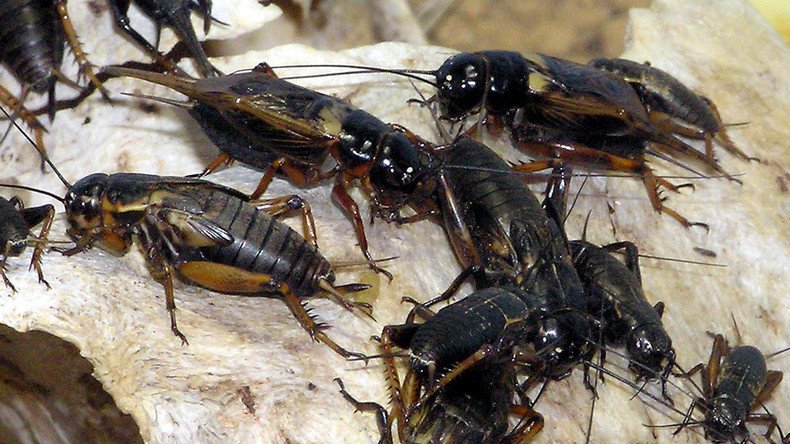'We're popularizing insect-eating': Japanese uni crowdfunds cricket farming tech

Japan’s Tokushima University has successfully collected public donations for a contraption that will help automatically provide water for crickets, with the ambition of turning ordinary people into farmers of nutritious insects.
“Let’s start a big movement from Japan where there is a tradition of eating insects such as locusts,” said a mission statement from the developmental biology team at the prestigious institution, in southern Japan, which had struggled to get academic funding for its pet project. “We can finally take a step toward popularizing insect-eating.”
After opening a drive to crowdfund 500,000 yen ($4,540) at the beginning of April on a Japanese version of Kickstarter, the team beat its deadline, set by the end of May, with more than 70 people donating enough money to make the project viable.
For 3,000 yen, contributors are entitled to a packet of powdered crickets, and a recipe book for cooking them. So far, they are said to go well with tonkatsu – breaded cutlets – and octopus dumpling, with a commenter suggesting that they could also make a desirable side snack to go with alcohol.
For 5,000 yen, the funder will receive a prototype device that will help in the farming of the Gryllus bimaculatus species, a fast-breeding 3-cm insect, which Tokushima’s researchers believe is particularly suitable for mass farming, due to its all-year reproductive cycle, and high protein content. The omnivorous insects will also need to feed on potatoes, fruits, bran and seeds to reach their maximum weight.
Those ready to fork out 10,000 have been invited to a tasting of the aforementioned specie, along with the research team itself.

The crowdfunding page remains open for donations.
“I thought many people would reject the idea of eating crickets because of their appearance, but there were an unexpectedly high number of responses to crowdfunding,” Taro Mito, who leads the team, told the Asahi Shimbun. “I feel the public has a high level of interest in food problems.”
US cricket growers spread their wings… slowly
While up to a billion people in the world eat at least some insects, interest in them among those who can afford other food was boosted by a UN report in 2013, which touted them as a solution for world hunger.
While Westerners have long sampled them on their travels through Asia, otherwise progress has been tentative.
Last year, the Atlantic reported that there are currently four major cricket-rearing farms operating in the US, though Popular Science reported that as many as 30 start-ups focused on breeding the animals have been hatched since 2012. Most of the producers grind their hothoused swarms into powder or flour, which is then transformed into baked goods or protein bars, for an audience that still largely views insect consumption as a culinary taboo.
Our latest recipe: Hummus with cricket flour! #superfoodhttps://t.co/ncb3Taj9o2pic.twitter.com/zXZ18sJ80X
— Entomo Farms (@EntomoFarms) May 27, 2016
Look what arrived today!! @AllThingsBugs@GrioPro looking forward to trying it out.. #cricketpowderpic.twitter.com/pT6lK3n4jw
— Gryllo Co (@GrylloCo) May 27, 2016
Cafes and food trucks offering cooked crickets – which are often described as having a meaty, full taste – in tacos, or as a fried snack, have also sprung up around the country, but have mostly remained a curiosity, with no major chains establishing their presence so far.













